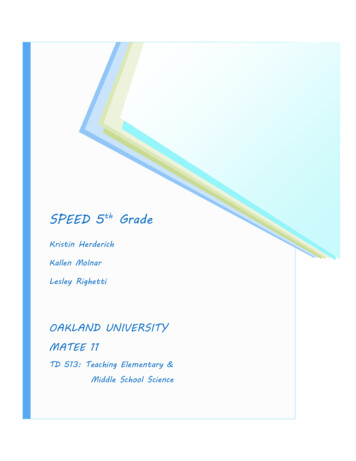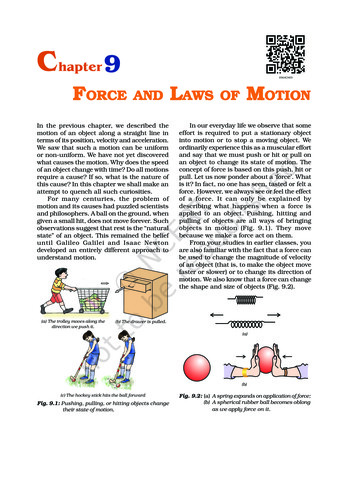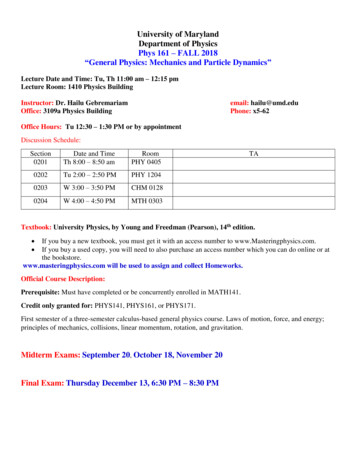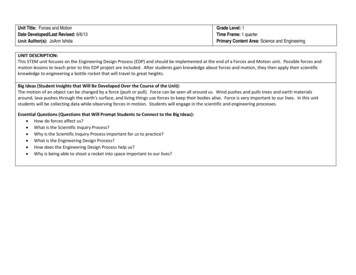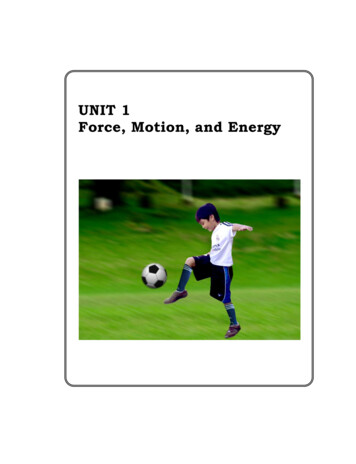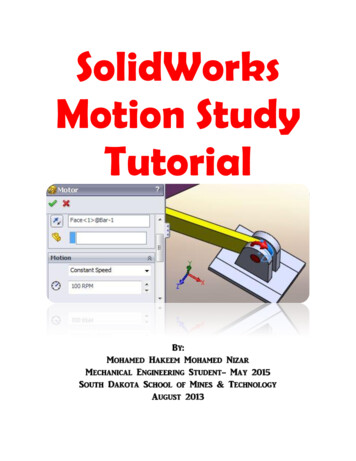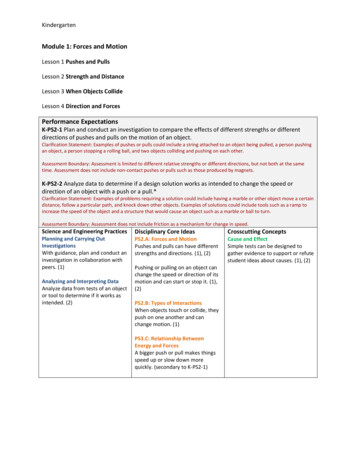
Transcription
KindergartenModule 1: Forces and MotionLesson 1 Pushes and PullsLesson 2 Strength and DistanceLesson 3 When Objects CollideLesson 4 Direction and ForcesPerformance ExpectationsK-PS2-1 Plan and conduct an investigation to compare the effects of different strengths or differentdirections of pushes and pulls on the motion of an object.Clarification Statement: Examples of pushes or pulls could include a string attached to an object being pulled, a person pushingan object, a person stopping a rolling ball, and two objects colliding and pushing on each other.Assessment Boundary: Assessment is limited to different relative strengths or different directions, but not both at the sametime. Assessment does not include non-contact pushes or pulls such as those produced by magnets.K-PS2-2 Analyze data to determine if a design solution works as intended to change the speed ordirection of an object with a push or a pull.*Clarification Statement: Examples of problems requiring a solution could include having a marble or other object move a certaindistance, follow a particular path, and knock down other objects. Examples of solutions could include tools such as a ramp toincrease the speed of the object and a structure that would cause an object such as a marble or ball to turn.Assessment Boundary: Assessment does not include friction as a mechanism for change in speed.Science and Engineering PracticesDisciplinary Core IdeasCrosscutting ConceptsPlanning and Carrying OutInvestigationsWith guidance, plan and conduct aninvestigation in collaboration withpeers. (1)PS2.A: Forces and MotionPushes and pulls can have differentstrengths and directions. (1), (2)Cause and EffectSimple tests can be designed togather evidence to support or refutestudent ideas about causes. (1), (2)Analyzing and Interpreting DataAnalyze data from tests of an objector tool to determine if it works asintended. (2)Pushing or pulling on an object canchange the speed or direction of itsmotion and can start or stop it. (1),(2)PS2.B: Types of InteractionsWhen objects touch or collide, theypush on one another and canchange motion. (1)PS3.C: Relationship BetweenEnergy and ForcesA bigger push or pull makes thingsspeed up or slow down morequickly. (secondary to K-PS2-1)
KindergartenModule 2: Energy and the SunLesson 1 Sunlight and Earth’s SurfaceLesson 2 Sunlight and ShadePerformance ExpectationsK-PS3-1 Make observations to determine the effect of sunlight on Earth’s surface.Clarification Statement: Examples of Earth’s surface could include sand, soil, rocks, and water.Assessment Boundary: Assessment of temperature is limited to relative measures such as warmer/cooler.K-PS3-2 Use tools and materials to design and build a structure that will reduce the warming effect ofsunlight on an area.*Clarification Statement: Examples of structures could include umbrellas, canopies, and tents that minimize the warming effectof the sun.Science and Engineering PracticesDisciplinary Core IdeasCrosscutting ConceptsPlanning and Carrying OutInvestigationsMake observations (firsthand orfrom media) to collect data that canbe used to make comparisons. (1)PS3.B: Conservation of Energy andEnergy TransferSunlight warms Earth’s surface. (1),(2)Cause and EffectEvents have causes that generateobservable patterns. (1), (2)Constructing Explanations andDesigning SolutionsUse tools and materials provided todesign and build a device that solvesa specific problem or a solution to aspecific problem. (2)
KindergartenModule 3: WeatherLesson 1 Weather PatternsLesson 2 Describe WeatherLesson 3 Forecast WeatherLesson 4 Severe WeatherPerformance ExpectationsK-ESS2-1 Use and share observations of local weather conditions to describe patterns over time.Clarification Statement: Examples of qualitative observations could include descriptions of the weather (such as sunny, cloudy,rainy, and warm); examples of quantitative observations could include numbers of sunny, windy, and rainy days in a month.Examples of patterns could include that it is usually cooler in the morning than in the afternoon and the number of sunny daysversus cloudy days in different months.Assessment Boundary: Assessment of quantitative observations limited to whole numbers and relative measures such aswarmer/cooler.K-ESS3-2 Ask questions to obtain information about the purpose of weather forecasting to prepare for,and respond to, severe weather.*Clarification Statement: Emphasis is on local forms of severe weather.Science and Engineering PracticesDisciplinary Core IdeasCrosscutting ConceptsAnalyzing and Interpreting DataUse observations (firsthand or frommedia) to describe patterns in thenatural world in order to answerscientific questions. (1)ESS2.D: Weather and ClimateWeather is the combination of sunlight,wind, snow or rain, and temperature ina particular region at a particular time.People measure these conditions todescribe and record the weather and tonotice patterns over time. (1)PatternsPatterns in the natural world can beobserved, used to describe phenomena,and used as evidence. (1)Asking Questions and DefiningProblemsAsk questions based on observations tofind more information about thedesigned world. (2)Obtaining, Evaluating, andCommunicating InformationRead grade-appropriate texts and/oruse media to obtain scientificinformation to describe patterns in thenatural world. (2)Module 4: Plants and AnimalsLesson 1 Plant and Animal NeedsLesson 2 Places Plants GrowESS3.B: Natural HazardsSome kinds of severe weather are morelikely than others in a given region.Weather scientists forecast severeweather so that the communities canprepare for and respond to theseevents. (2)ETS1.A: Defining and Delimiting anEngineering ProblemAsking questions, making observations,and gathering information are helpful inthinking about problems. (secondary toK-ESS3-2)Cause and EffectEvents have causes that generateobservable patterns. (2)
KindergartenLesson 3 Animal HabitatsPerformance ExpectationsK-LS1-1 Use observations to describe patterns of what plants and animals (including humans) need tosurvive.Clarification Statement: Examples of patterns could include that animals need to take in food but plants do not; the differentkinds of food needed by different types of animals; the requirement of plants to have light; and, that all living things needwater.K-ESS3-1 Use a model to represent the relationship between the needs of different plants or animals(including humans) and the places they live.Clarification Statement: Examples of relationships could include that deer eat buds and leaves, therefore, they usually live inforested areas; and, grasses need sunlight so they often grow in meadows. Plants, animals, and their surroundings make up asystem.Science and Engineering PracticesDisciplinary Core IdeasCrosscutting ConceptsAnalyzing and Interpreting DataUse observations (firsthand or frommedia) to describe patterns in thenatural world in order to answerscientific questions. (L1)LS1.C: Organization for Matter andEnergy Flow in OrganismsAll animals need food in order tolive and grow. They obtain theirfood from plants or from otheranimals. Plants need water and lightto live and grow. (L1)PatternsPatterns in the natural and humandesigned world can be observedand used as evidence. (L1)Developing and Using ModelsUse a model to representrelationships in the natural world.(E1)ESS3.A: Natural ResourcesLiving things need water, air, andresources from the land, and theylive in places that have the thingsthey need. Humans use naturalresources for everything they do.(E1)Systems and System ModelsSystems in the natural and designedworld have parts that worktogether. (E1)Module 5: Impact on the Earth’s SystemsLesson 1 Plants Change Their EnvironmentsLesson 2 Animals Change Their EnvironmentsLesson 3 People Change EnvironmentsPerformance ExpectationK-ESS2-2 Construct an argument supported by evidence for how plants and animals (including humans)can change the environment to meet their needs.Clarification Statement: Examples of plants and animals changing their environment could include a squirrel digs in the groundto hide its food and tree roots can break concrete.Science and Engineering PracticesDisciplinary Core IdeasCrosscutting ConceptsEngaging In Argument fromEvidenceConstruct an argument withESS2.E: BiogeologyPlants and animals can change theirenvironment.Systems and System ModelsSystems in the natural and designedworld have parts that work
Kindergartenevidence to support a claim.together.ESS3.C: Human Impacts on EarthSystemsThings that people do to livecomfortably can affect the worldaround them. But they can makechoices that reduce their impacts onthe land, water, air, and other livingthings. (secondary to K-ESS2-2)Module 6: Protecting Our EarthLesson 1 Land, Air, and Water PollutionLesson 2 Help Save Natural ResourcesLesson 3 Reduce, Reuse, RecyclePerformance ExpectationsK-ESS3-3 Communicate solutions that will reduce the impact of humans on the land, water, air, and/orother living things in the local environment.*Clarification Statement: Examples of human impact on the land could include cutting trees to produce paper and usingresources to produce bottles. Examples of solutions could include reusing paper and recycling cans and bottles.Science and Engineering PracticesDisciplinary Core IdeasCrosscutting ConceptsObtaining, Evaluating, andCommunicating InformationCommunicate solutions with othersin oral and/or written forms usingmodels and/or drawings thatprovide detail about scientific ideas.ESS3.C: Human Impacts on EarthSystemsThings that people do to livecomfortably can affect the worldaround them. But they can makechoices that reduce their impacts onthe land, water, air, and other livingthings.Cause and EffectEvents have causes that generateobservable patterns.ETS1.B: Developing PossibleSolutionsDesigns can be conveyed throughsketches, drawings, or physicalmodels. These representations areuseful in communicating ideas for aproblem’s solutions to other people.(secondary to K-ESS3-3)
Grade 1Module 1: Sound EnergyLesson 1 SoundLesson 2 Making SoundsPerformance Expectation1-PS4-1 Plan and conduct investigations to provide evidence that vibrating materials can make soundand that sound can make materials vibrate.Clarification Statement:Examples of vibrating materials that make sound could include tuning forks and plucking a stretched string.Examples of how sound can make matter vibrate could include holding a piece of paper near a speaker making sound andholding an object near a vibrating tuning fork.Science and Engineering PracticesDisciplinary Core IdeasCrosscutting ConceptsPlanning and Carrying OutInvestigationsPlan and conduct investigationscollaboratively to produce data toserve as the basis for evidence toanswer a question.PS4.A: Wave PropertiesSound can make matter vibrate, andvibrating matter can make sound.Cause and EffectSimple tests can be designed togather evidence to support or refutestudent ideas about causes.Module 2: Light EnergyLesson 1 Light and ShadowsLesson 2 Properties of LightLesson 3 How Light TravelsPerformance Expectations1-PS4-2 Make observations to construct an evidence-based account that objects can be seen only whenilluminated.Clarification Statement: Examples of observations could include those made in a completely dark room, a pinhole box, and avideo of a cave explorer with a flashlight. Illumination could be from an external light source or by an object giving off its ownlight.1-PS4-3 Plan and conduct an investigation to determine the effect of placing objects made with differentmaterials in the path of a beam of light.Clarification Statement: Examples of materials could include those that are transparent (such as clear plastic), translucent (suchas wax paper), opaque (such as cardboard), and reflective (such as a mirror).Assessment Boundary: Assessment does not include the speed of light.Science and Engineering PracticesDisciplinary Core IdeasCrosscutting ConceptsPlanning and Carrying OutInvestigationsPlan and conduct investigationscollaboratively to produce data toPS4.B: Electromagnetic RadiationObjects can be seen if light isavailable to illuminate them or ifthey give off their own light. (2)Cause and EffectSimple tests can be designed togather evidence to support or refutestudent ideas about causes. (2), (3)
Grade 1serve as the basis for evidence toanswer a question. (3)Constructing Explanations andDesigning SolutionsMake observations (firsthand orfrom media) to construct anevidence-based account for naturalphenomena. (2)Some materials allow light to passthrough them, others allow onlysome light through and others blockall the light and create a darkshadow on any surface beyondthem, where the light cannot reach.Mirrors can be used to redirect alight beam. (Boundary: The ideathat light travels from place to placeis developed through experienceswith light sources, mirrors, andshadows, but no attempt is made todiscuss the speed of light.) (3)Module 3: Use Energy to CommunicateLesson 1 Communicate with SoundLesson 2 Communicate with LightPerformance Expectation1-PS4-4 Use tools and materials to design and build a device that uses light or sound to solve theproblem of communicating over a distance.*Clarification Statement: Examples of devices could include a light source to send signals, paper cup and string “telephones,” anda pattern of drum beats.Assessment Boundary: Assessment does not include technological details for how communication devices work.Science and Engineering PracticesDisciplinary Core IdeasConstructing Explanations andDesigning SolutionsUse tools and materials provided todesign a device that solves a specificproblem.PS4.C: Information Technologiesand InstrumentationPeople also use a variety of devicesto communicate (send and receiveinformation) over long distances.Crosscutting Concepts
Grade 1Module 4: Plant and Animal PartsLesson 1 Living and Nonliving ThingsLesson 2 Parts of PlantsLesson 3 Parts of AnimalsLesson 4 Plant and Animal SurvivalPerformance Expectation1-LS1-1 Use materials to design a solution to a human problem by mimicking how plants and/or animalsuse their external parts to help them survive, grow, and meet their needs.*Clarification statement: Examples of human problems that can be solved by mimicking plant or animal solutions could include: designing clothing or equipment to protect bicyclists by mimicking turtle shells, acorn shells, and animal scales; stabilizing structures by mimicking animal tails and roots on plants; keeping out intruders by mimicking thorns on branches and animal quills; and detecting intruders by mimicking eyes and ears.Science and Engineering PracticesDisciplinary Core IdeasCrosscutting ConceptsConstructing Explanations andDesigning SolutionsUse materials to design a devicethat solves a specific problem or asolution to a specific problem.LS1.A: Structure and FunctionAll organisms have external parts.Different animals use their bodyparts in different ways to see, hear,grasp objects, protect themselves,move from plac6e to place, andseek, find, and take in food, waterand air.Structure and FunctionThe shape and stability of structuresof natural and designed objects arerelated to their function(s).Plants also have different parts(roots, stems, leaves, flowers, fruits)that help them survive and grow.LS1.D: Information ProcessingAnimals have body parts thatcapture and convey different kindsof information needed for growthand survival. Animals respond tothese inputs with behaviors thathelp them survive.Plants also respond to someexternal inputs.Module 5: Offspring and Their ParentsLesson 1 Plants Grow and Change
Grade 1Lesson 2 Plants and Their ParentsLesson 3 Compare AnimalsLesson 4 Animals and Their ParentsLesson 5 Offspring and SurvivalPerformance Expectations1-LS1-2 Read texts and use media to determine patterns in behavior of parents and offspring that helpoffspring survive.Clarification Statement: Examples of patterns of behaviors could include the signals that offspring make (such as crying,cheeping, and other vocalizations) and the responses of the parents (such as feeding, comforting, and protecting the offspring).1-LS3-1 Make observations to construct an evidence-based account that young plants and animals arelike, but not exactly like, their parents.Clarification Statement: Examples of patterns could include features plants or animals share. Examples of observations couldinclude leaves from the same kind of plant are the same shape but can differ in size; and, a particular breed of dog looks like itsparents but is not exactly the same.Assessment Boundary: Assessment does not include inheritance or animals that undergo metamorphosis or hybrids.Science and Engineering PracticesDisciplinary Core IdeasCrosscutting ConceptsObtaining, Evaluating, andCommunicating InformationRead grade-appropriate texts anduse media to obtain scientificinformation to determine patternsin the natural world. (2)LS1.B: Growth and Development ofOrganismsAdult plants and animals can haveyoung. In many kinds of animals,parents and the offspringthemselves engage in behaviors thathelp the offspring to survive. (2)PatternsPatterns in the natural world can beobserved, used to describephenomena, and used as evidence.(2, 1)Constructing Explanations andDesigning SolutionsMake observations (firsthand orfrom media) to construct anevidence-based account for naturalphenomena. (1)LS3.A: Inheritance of TraitsYoung animals are very much, butnot exactly like, their parents. (1)Plants are also very much, but notexactly, like their parents. (1)LS3.B: Variation of TraitsIndividuals of the same kind of plantor animal are recognizable as similarbut can also vary in many ways. (1)Module 6: Earth and SpaceLesson 1 Day and NightLesson 2 Seasonal PatternsLesson 3 The MoonLesson 4 The Sun and Stars
Grade 1Performance Expectations1-ESS1-1 Use observations of the sun, moon, and stars to describe patterns that can be predicted.Clarification Statement: Examples of patterns could include that the sun and moon appear to rise in one part of the sky, moveacross the sky, and set; and stars other than our sun are visible at night but not during the day.Assessment Boundary: Assessment of star patterns is limited to stars being seen at night and not during the day.1-ESS1-2 Make observations at different times of year to relate the amount of daylight to the time ofyear.Clarification Statement: Emphasis is on relative comparisons of the amount of daylight in the winter to the amount in the springor fall.Assessment Boundary: Assessment is limited to relative amounts of daylight, not quantifying the hours or time of daylight.Science and Engineering PracticesDisciplinary Core IdeasCrosscutting ConceptsPlanning and Carrying OutInvestigationsMake observations (firsthand orfrom media) to collect data that canbe used to make comparisons. (2)ESS1.A: The Universe and Its StarsPatterns of the motion of the sun,moon, and stars in the sky can beobserved, described, and predicted.(1)PatternsPatterns in the natural world can beobserved, used to describephenomena, and used as evidence.(1), (2)Analyzing and Interpreting DataUse observations (firsthand or frommedia) to describe patterns in thenatural world in order to answerscientific questions. (1)ESS1.B: Earth and the Solar SystemSeasonal patterns of sunrise andsunset can be observed, described,and predicted. (2)
Grade 2Module 1: Properties of MatterLesson 1 Describe MatterLesson 2 SolidsLesson 3 Liquids and GasesLesson 4 Use MatterPerformance Expectations2-PS1-1 Plan and conduct an investigation to describe and classify different kinds of materials by theirobservable properties.Clarification Statement: Observations could include color, texture, hardness, and flexibility. Patterns could include the similarproperties that different materials share.2-PS1-2 Analyze data obtained from testing different materials to determine which materials have theproperties that are best suited for an intended purpose.*Clarification Statement: Examples of properties could include, strength, flexibility, hardness, texture, and absorbency.Assessment Boundary: Assessment of quantitative measurements is limited to length.Science and Engineering PracticesDisciplinary Core IdeasCrosscutting ConceptsPlanning and Carrying OutInvestigationsPlan and conduct an investigationcollaboratively to produce data toserve as the basis for evidence toanswer a question. (1)PS1.A: Structure and Properties ofMatterDifferent kinds of matter exist andmany of them can be either solid orliquid, depending on temperature.Matter can be described andclassified by its observableproperties. (1)PatternsPatterns in the natural and humandesigned world can be observed. (1)Analyzing and Interpreting DataAnalyze data from tests of an objector tool to determine if it works asintended. (2)Different properties are suited todifferent purposes. (2), (3)Cause and EffectSimple tests can be designed togather evidence to support or refutestudent ideas about causes. (2)
Grade 2Module 2: Changes to MatterLesson 1 Put Matter TogetherLesson 2 MixturesLesson 3 Temperature Changes MatterPerformance Expectations2-PS1-3 Make observations to construct an evidence-based account of how an object made of a smallset of pieces can be disassembled and made into a new object.Clarification Statement: Examples of pieces could include blocks, building bricks, or other assorted small objects.2-PS1-4 Construct an argument with evidence that some changes caused by heating or cooling can bereversed and some cannot.Clarification Statement: Examples of reversible changes could include materials such as water and butter at differenttemperatures. Examples of irreversible changes could include cooking an egg, freezing a plant leaf, and heating paper.Science and EngineeringPracticesEngaging in Argument fromEvidenceConstruct an argument withevidence to support a claim. (4)Constructing Explanations andDesigning SolutionsMake observations (firsthand orfrom media) to construct anevidence-based account for naturalphenomena. (3)Module 3: Earth’s SurfaceLesson 1 Describe Earth’s SurfaceLesson 2 OceansLesson 3 Fresh WaterLesson 4 Use MapsPerformance ExpectationsDisciplinary Core IdeasCrosscutting ConceptsPS1.A: Structure and Properties ofMatterEnergy and MatterObjects may break into smallerpieces and be put together intolarger pieces, or change shapes. (3)Different properties are suited todifferent purposes. (2), (3)A great variety of objects can bebuilt up from a small set of pieces.(3)PS1.B: Chemical ReactionsHeating or cooling a substance maycause changes that can beobserved. Sometimes these changesare reversible, and sometimes theyare not. (4)Cause and EffectEvents have causes that generateobservable patterns. (4)
Grade 22-ESS2-3 Obtain information to identify where water is found on Earth and that it can be solid or liquid.2-ESS2-2 Develop a model to represent the shapes and kinds of land and bodies of water in an area.Assessment Boundary: Assessment does not include quantitative scaling in models.Science and EngineeringPracticesDeveloping and Using ModelsDevelop a model to representpatterns in the natural world. (2)Obtaining, Evaluating, andCommunicating InformationObtain information using varioustexts, text features (e.g., headings,tables of contents, glossaries,electronic menus, icons), and othermedia that will be useful inanswering a scientific question. (3)Disciplinary Core IdeasCrosscutting ConceptsESS2.B: Plate Tectonics and LargeScale System InteractionsMaps show where things arelocated. One can map the shapesand kinds of land and water in anyarea. (2)PatternsPatterns in the natural world can beobserved. (2), (3)ESS2.C: The Roles of Water inEarth’s Surface ProcessesWater is found in the ocean, rivers,lakes, and ponds. Water exists assolid ice and in liquid form. (3)Module 4: Earth’s Surface ChangesLesson 1 Weathering and ErosionLesson 2 Quick Changes to Earth’s SurfaceLesson 3 People Change EarthPerformance Expectations2-ESS1-1 Use information from several sources to provide evidence that Earth events can occur quicklyor slowly.Clarification Statement: Examples of events and timescales could include volcanic explosions and earthquakes, which happenquickly and erosion of rocks, which occurs slowly.Assessment Boundary: Assessment does not include quantitative measurements of timescales.2-ESS2-1 Compare multiple solutions designed to slow or prevent wind or water from changing theshape of the land.*Clarification Statement: Examples of solutions could include different designs of dikes and windbreaks to hold back wind andwater, and different designs for using shrubs, grass, and trees to hold back the land.Science and EngineeringPracticesConstructing Explanations andDesigning SolutionsMake observations from severalsources to construct an evidencebased account for naturalphenomena. (1-1)Disciplinary Core IdeasCrosscutting ConceptsESS1.C: The History of Planet EarthSome events happen very quickly;others occur very slowly, over atime period much longer than onecan observe. (1-1)Stability and ChangeThings may change slowly or rapidly.(1-1), (2-1)ESS2.A: Earth Materials andSystemsWind and water can change the
Grade 2shape of the land. (2-1)ETS1.C: Optimizing the DesignSolutionBecause there is always more thanone possible solution to a problem,it is useful to compare and testdesigns. (secondary to 2-1)Module 5: Living Things in HabitatsLesson 1 HabitatsLesson 2 Forests and GrasslandsLesson 3 Water HabitatsLesson 4 Hot and Cold DesertsPerformance Expectation2-LS4-1 Make observations of plants and animals to compare the diversity of life in different habitats.Clarification Statement: Emphasis is on the diversity of living things in each of a variety of different habitats.Assessment Boundary: Assessment does not include specific animal and plant names in specific habitats.Science and Engineering PracticesDisciplinary Core IdeasCrosscutting ConceptsPlanning and Carrying OutInvestigationsMake observations (firsthand orfrom media) to collect data whichcan be used to make comparisons.LS4.D: Biodiversity and HumansThere are many different kinds ofliving things in any area, and theyexist in different places on land andin water.Structure and function. The shapeand stability of structures of naturaland designed objects are related totheir function(s).Module 6: Plants and Their NeedsLesson 1 Plants Need WaterLesson 2 Plants Need LightLesson 3 Plants Make More PlantsPerformance Expectations2-LS2-1 Plan and conduct an investigation to determine if plants need sunlight and water to grow.Assessment Boundary: Assessment is limited to testing one variable at a time.2-LS2-2 Develop a simple model that mimics the function of an animal in dispersing seeds or pollinating
Grade 2plants.*Science and Engineering PracticesDisciplinary Core IdeasCrosscutting ConceptsPlanning and Carrying OutInvestigationsPlan and conduct an investigationcollaboratively to produce data toserve as the basis for evidence toanswer a question. (1)LS2.A: InterdependentRelationships in EcosystemsPlants depend on water and light togrow. (1)Cause and EffectEvents have causes that generateobservable patterns. (1)Developing and Using ModelsDevelop a simple model based onevidence to represent a proposedobject or tool. (2)Plants depend on animals forpollination or to move their seedsaround. (2)ETS1.B: Developing PossibleSolutionsDesigns can be conveyed throughsketches, drawings, or physicalmodels. These representations areuseful in communicating ideas for aproblem’s solutions to other people.(secondary to 2-LS2-2)Structure and FunctionThe shape and stability of structuresof natural and designed objects arerelated to their function(s). (2)
Grade 3Module 1 Motion, Balanced and Unbalanced ForcesLesson 1 MotionLesson 2 Forces Can Change MotionLesson 3 Simple MachinesPerformance Expectations3-PS2-1. Plan and conduct an investigation to provide evidence of the effects of balanced andunbalanced forces on the motion of an object. Clarification Statement: Examples could include an unbalanced forceon one side of a ball can make it start moving; and, balanced forces pushing on a box from both sides will not produce anymotion at all.Assessment Boundary: Assessment is limited to one variable at a time: number, size, or direction of forces. Assessment doesnot include quantitative force size, only qualitative and relative. Assessment is limited to gravity being addressed as a force thatpulls objects down.3-PS2-2. Make observations and/or measurements of an object’s motion to provide evidence that apattern can be used to predict future motion. Clarification Statement: Examples of motion with a predictablepattern could include a child swinging in a swing, a ball rolling back and forth in a bowl, and two children on a see-saw.Assessment Boundary: Assessment does not include technical terms such as period and frequency.Science and Engineering PracticesDisciplinary Core IdeasCrosscutting ConceptsPlanning and Carrying OutInvestigationsPlan and conduct an investigationcollaboratively to produce data toserve as the basis for evidence,using fair tests in which variablesare controlled and the number oftrials considered. (3-PS2-1)PS2.A: Forces and MotionEach force acts on one particularobject and has both strength and adirection. An object at rest typicallyhas multiple forces acting on it, butthey add to give zero net force on theobject. Forces that do not sum tozero can cause changes in theobject’s speed or direction of motion.(Boundary: Qualitative andconceptual, but not quantitativeaddition of forces are used at thislevel.) (3-PS2-1)PatternsPatterns of change can be used tomake predictions. (3-PS2-2)Make observations and/ormeasurements to produce data toserve as the basis for evidence foran explanation of a phenomenon ortest a design solution. (3-PS2-2)The patterns of an object’s motion invarious situations can be observedand me
PS2.A: Forces and Motion strengths and directions. (1), (2) motion and can start or stop it. (1), (2) PS2.B: Types of Interactions touch or collide, they push on one another and can change motion. (1) PS3.C: Relationship Between Energy and Forces A bigger push or pull makes things speed up or slow down more quickly. (secondary to K-PS2-1)

